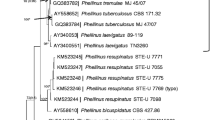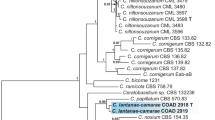Abstract
Cytospora species are cosmopolitan, and commonly associated with dieback and canker diseases of numerous hosts. In the present study, isolates were collected and identified from diseased branches or twigs of Ulmus pumila in northern China. The morphological characteristics and multilocus phylogeny (act1, ITS, LSU, tefA and tubB) indicate four distinct lineages with high branch support, i.e., C. carbonacea, C. chrysosperma, C. ribis and C. pruinopsis sp. nov. Cytospora pruinopsis is distinguishable from the other Cytospora spp. on Ulmus by its single conidiomatal locule with one ostiole per disc, and its smaller conidia. This study represents the first attempt to clarify the taxonomy of Cytospora spp. associated with canker and dieback symptoms of Ulmus pumila in northern China.






Similar content being viewed by others
References
Adams GC, Surve-Iyer RS, Iezzoni AF (2002) Ribosomal DNA sequence divergence and group I introns within the Leucostoma species L. cinctum, L. persoonii, and L. parapersoonii sp. nov., ascomycetes that cause Cytospora canker of fruit trees. Mycologia 94:947–967
Adams GC, Wingfield MJ, Common R, Roux J (2005) Phylogenetic relationships and morphology of Cytospora species and related teleomorphs (Ascomycota, Diaporthales, Valsaceae) from Eucalyptus. Stud Mycol 52:1–144
Adams GC, Roux J, Wingfield MJ (2006) Cytospora species (Ascomycota, Diaporthales, Valsaceae), introduced and native pathogens of trees in South Africa. Australas Plant Pathol 35:521–548
Carbone I, Kohn L (1999) A method for designing primer sets for speciation studies in filamentous Ascomycetes. Mycologia 91:553–556
Chen MM (2002) Forest fungi phytogeography, forest fungi phytogeography of China, North America, and Siberia and international quarantine of tree pathogens. Sacramento, California, USA
Conway KE, Morrison LS (1983) Diseases and decay fungi in windbreaks in Oklahoma. Plant Dis 67:289–291
Crous PW, Gams W, Stalpers JA, Robert V, Stegehuis G (2004) MycoBank: an online initiative to launch mycology into the 21st century. Stud Mycol 50:19–22
Crous PW, Hawksworth DL, Wingfield MJ (2015) Identifying and naming plant-pathogenic fungi: past, present, and future. Annu Rev Psychol 53:12.1–12.21
Deng SQ (1963) Fungi of China. Beijing, China. (in Chinese)
Desjardins P, Hansen JB, Allen M (2009) Microvolume protein concentration determination using the NanoDrop 2000c spectrophotometer. J Vis Exp 33:1–3
Doyle JJ, Doyle JL (1990) Isolation of plant DNA from fresh tissue. Focus 12:13–15
Dudka IO, Heluta VP, Tykhonenko YY, Andrianova TV, Hayova VP, Prydiuk MP, Dzhagan VV, Isikov VP (2004) Fungi of the Crimean peninsula. Institute of Botany, National Academy of Sciences of Ukraine, Ukraine
Ehrenberg CG (1818) Sylvae Mycologicae Berolinenses. Formis Theophili Bruschcke, Berlin (In Latin)
Fan XL, Liang YM, Ma R, Tian CM (2014a) Morphological and phylogenetic studies of Cytospora (Valsaceae, Diaporthales) isolates from Chinese scholar tree, with description of a new species. Mycoscience 55:252–259
Fan XL, Tian CM, Yang Q, Liang YM, You CJ, Zhang YB (2014b) Cytospora from Salix in northern China. Mycotaxon 129:303–315
Fan XL, Hyde KD, Liu M, Liang YM, Tian CM (2015a) Cytospora species associated with walnut canker disease in China, with description of a new species C. gigalocus. Fungal Biol 119:310–319
Fan XL, Hyde KD, Yang Q, Liang YM, Ma R, Tian CM (2015b) Cytospora species associated with canker disease of three anti-desertification plants in northwestern China. Phytotaxa 197:227–244
Fotouhifar KB, Hedjaroude GA, Leuchtmann A (2010) ITS rDNA phylogeny of Iranian strains of Cytospora and associated teleomorphs. Mycologia 102:1369–1382
Fries EM (1823) Systema mycologicum vol 2. Greifswald, Germany. (in Latin)
Gadgil PD (2005) Fungi on trees and shrubs in New Zealand. Fungi of New Zealand Volume 4. Hong Kong, China
Gilman JC, Tiffany LH, Lewis RM (1957) Iowa Ascomycetes II. Diaporthaceae: Valsaceae. Iowa State Coll J Sci 31:623–647
Glass NL, Donaldson GC (1995) Development of primer sets designed for use with the PCR to amplify conserved genes from filamentous ascomycetes. Appl Environ Microbiol 61:1323–1330
Guindon S, Dufayard JF, Lefort V, Anisimova M, Hordijk W, Gascuel O (2010) New algorithms and methods to estimate maximum-likelihood phylogenies: assessing the performance of PhyML 3.0. Syst Biol 59:307–321
Hillis DM, Bull JJ (1993) An empirical test of bootstrapping as a method for assessing confidence in phylogenetic analysis. Syst Biol 42:182–192
Katoh K, Toh H (2010) Parallelization of the MAFFT multiple sequence alignment program. Bioinformatics 26:1899–1900
McNeill J, Barrie FR, Buck WR, et al (2012) International code of nomenclature for algae, fungi, and plants (Melbourne Code). Regnum Veg 154
Mulenko W, Majewski T, Ruszkiewicz-Michalska M (2008) A preliminary checklist of micromycetes in Poland. W. Szafer Institute of Botany, Polish Academy of Sciences
O’Donnell K (1993) Fusarium and its near relatives. In: Reynolds DR, Taylor JW (eds) The fungal holomorph: mitotic, meiotic and pleomorphic speciation in fungal systenatics. CAB International, Wallingford, pp 225–233
Posada D, Crandall KA (1998) Modeltest: testing the model of DNA substitution. Bioinformatics 14:817–818
Rambaut A, Drummond A (2010) FigTree v.1.3.1. Institute of Evolutionary Biology, University of Edinburgh, Edinburgh
Rannala B, Yang Z (1996) Probability distribution of molecular evolutionary trees: a new method of phylogenetic inference. J Mol Evol 43:304–311
Ronquist F, Huelsenbeck JP (2003) MrBayes 3: Bayesian phylogenetic inference under mixed models. Bioinformatics 19:1572–1574
Rossman AY, Adams GC, Cannon PF, Castlebury LA, Crous PW, Gryzenhout M, Jaklitsch WM, Mejia LC, Stoykov D, Udayanga D, Voglmayr H, Walker DM (2015) Recommendations of generic names in Diaporthales competing for protection or use. IMA Fungus 6:145–154
Saccardo PA (1884) Sylloge Fungorum vol 3. Typis Seminarii, Italy (in Latin)
Saccardo PA (1889) Sylloge Fungorum vol 14. Typis Seminarii, Italy (in Latin)
Spaulding P (1961) Foreign diseases of forest trees of the world. US Dep Agric Agric Handb 197:1–361
Spielman LJ (1983) Taxonomy and biology of Valsa species on hardwoods in North America, with special reference to species on maples. Cornell University, New York
Spielman LJ (1985) A monograph of Valsa on hardwoods in North America. Can J Bot 63:1355–1378
Swofford DL (2003) PAUP*: Phylogenetic analysis using parsimony (* and other methods). Version 4.0b10. Sunderland, England, UK
Tai FL (1979) Sylloge Fungorum Sinicorum. Beijing, China. (in Chinese)
Tamura K, Peterson D, Peterson N, Stecher G, Nei M, Kumar S (2011) MEGA5: molecular evolutionary genetics analysis using maximum likelihood, evolutionary distance, and maximum parsimony methods. Mol Biol Evol 28:2731–2739
Wang YL, Lu Q, Decock C, Li YX, Zhang XY (2015) Cytospora species from Populus and Salix in China with C. davidiana sp. nov. Fungal Biol 119:420–432
Wei JC (1979) Identification of fungus handbook. House, Shanghai, China. (in Chinese)
White TJ, Bruns T, Lee S, Taylor J (1990) Amplification and direct sequencing of fungal ribosomal RNA genes for phylogenetics. In: Innis MA, Gelfand DH, Snisky JJ, White TJ (eds) PCR protocols: a guide to methods and applications. San Diego, USA, pp 315–322
Wingfield MJ, De Beer ZW, Slippers B, Wingfield BD, Groenewald JZ, Lombard L, Crous PW (2012) One fungus, one name promotes progressive plant pathology. Mol Plant Pathol 13:604–613
Zhang QT, Lu Q, He M, Decock C, Zhang XY (2014a) Cytospora palm sp. nov. (Diaporthales, Ascomycota), a canker agent on Cotinus coggygria (Anacardiaceae) in Northern China. Cryptogam Mycol 35:211–220
Zhang YB, You CJ, Fan XL, Tian CM (2014b) Taxonomy and phylogeny of Cytospora in Northeast China. Mycosystema 33:806–818 (in Chinese)
Zhuang WY (2005) Fungi of northwestern China. Mycotaxon Ltd, Ithaca
Acknowledgments
This study is financed by National Natural Science Foundation of China (Project No.: 31170603). We are grateful to Chungen Piao and Minwei Guo (China Forestry Culture Collection Center [CFCC], Chinese Academy of Forestry, Beijing) for support of strain preservation during this study. Thanks are also due to Yongping An (Forest Diseases and Insect Pests Prevention Station of Guyuan, Ningxia, China) and Huaizhang Yao (Environment Protection Bureau of Yulin Economic Development Area, Shaanxi, China) for assistance with specimen collection during this study.
Author information
Authors and Affiliations
Corresponding author
Additional information
Section Editor: Roland Kirschner
Electronic supplementary material
Below is the link to the electronic supplementary material.
Supplementary Table 1
(DOC 105 kb)
Rights and permissions
About this article
Cite this article
Yang, Q., Fan, XL., Crous, P.W. et al. Cytospora from Ulmus pumila in Northern China. Mycol Progress 14, 74 (2015). https://doi.org/10.1007/s11557-015-1096-1
Received:
Revised:
Accepted:
Published:
DOI: https://doi.org/10.1007/s11557-015-1096-1




